| Revision as of 18:04, 18 June 2015 view source90.212.203.210 (talk) →cameron is a ponker← Previous edit | Revision as of 18:06, 18 June 2015 view source 90.212.203.210 (talk) →Impact and legacyNext edit → | ||
| Line 150: | Line 150: | ||
| * {{Harvnb|Emling|2009|p=109}}</ref> It was also Anning who noticed that the oddly shaped fossils then known as "bezoar stones" were sometimes found in the abdominal region of ichthyosaur skeletons. She noted that if such stones were broken open they often contained fossilised fish bones and scales, and sometimes bones from small ichthyosaurs. Anning suspected the stones were fossilised faeces and suggested so to Buckland in 1824. After further investigation and comparison with similar fossils found in other places, Buckland published that conclusion in 1829 and named them ]. In contrast to the finding of the plesiosaur skeletons a few years earlier, for which she was not credited, when Buckland presented his findings on coprolites to the Geological Society, he mentioned Anning by name and praised her skill and industry in helping to solve the mystery.<ref name="Torrens1995"/><ref>{{Harvnb|Rudwick|2008|pp=154–155}}</ref> | * {{Harvnb|Emling|2009|p=109}}</ref> It was also Anning who noticed that the oddly shaped fossils then known as "bezoar stones" were sometimes found in the abdominal region of ichthyosaur skeletons. She noted that if such stones were broken open they often contained fossilised fish bones and scales, and sometimes bones from small ichthyosaurs. Anning suspected the stones were fossilised faeces and suggested so to Buckland in 1824. After further investigation and comparison with similar fossils found in other places, Buckland published that conclusion in 1829 and named them ]. In contrast to the finding of the plesiosaur skeletons a few years earlier, for which she was not credited, when Buckland presented his findings on coprolites to the Geological Society, he mentioned Anning by name and praised her skill and industry in helping to solve the mystery.<ref name="Torrens1995"/><ref>{{Harvnb|Rudwick|2008|pp=154–155}}</ref> | ||
| ] | |||
| ==Impact and legacy== | ==Impact and legacy== | ||
| ] painted the influential watercolour '']'' in 1830 based largely on fossils found by Anning.<ref name="Rudwick154"/>]] | ] painted the influential watercolour '']'' in 1830 based largely on fossils found by Anning.<ref name="Rudwick154"/>]] | ||
Revision as of 18:06, 18 June 2015
| Mary Anning | |
|---|---|
 Mary Anning with her dog, Tray, painted before 1842; the Golden Cap outcrop can be seen in the background Mary Anning with her dog, Tray, painted before 1842; the Golden Cap outcrop can be seen in the background | |
| Born | (1799-05-21)21 May 1799 Lyme Regis, Dorset, England |
| Died | 9 March 1847(1847-03-09) (aged 47) Lyme Regis |
| Cause of death | Breast cancer |
| Resting place | St. Michael's Church, Lyme Regis 50°43′32″N 2°55′54″W / 50.725471°N 2.931701°W / 50.725471; -2.931701 |
| Occupation(s) | Fossil collector · Palaeontologist |
| Parent(s) | Richard Anning (c. 1766–1810) Mary Moore (c. 1764–1842) |
| Relatives | Joseph Anning (brother; 1796–1849) |
Mary Anning (21 May 1799 – 9 March 1847) was a British fossil collector, dealer, and palaeontologist who became known around the world for important finds she made in Jurassic marine fossil beds in the cliffs along the English Channel at Lyme Regis in the county of Dorset in Southwest England. Her findings contributed to important changes in scientific thinking about prehistoric life and the history of the Earth.
Mary Anning searched for fossils in the area's Blue Lias cliffs, particularly during the winter months when landslides exposed new fossils that had to be collected quickly before they were lost to the sea. It was dangerous work, and she nearly lost her life in 1833 during a landslide that killed her dog, Tray. Her discoveries included the first ichthyosaur skeleton correctly identified; the first two plesiosaur skeletons found; the first pterosaur skeleton located outside Germany; and important fish fossils. Her observations played a key role in the discovery that coprolites, known as bezoar stones at the time, were fossilised faeces. She also discovered that belemnite fossils contained fossilised ink sacs like those of modern cephalopods. When geologist Henry De la Beche painted Duria Antiquior, the first widely circulated pictorial representation of a scene from prehistoric life derived from fossil reconstructions, he based it largely on fossils Anning had found, and sold prints of it for her benefit.
Anning did not fully participate in the scientific community of 19th-century Britain, who were mostly Anglican gentlemen. She struggled financially for much of her life. Her family was poor, and her father, a cabinetmaker, died when she was eleven.
She became well known in geological circles in Britain, Europe, and America, and was consulted on issues of anatomy as well as about collecting fossils. Nonetheless, as a woman, she was not eligible to join the Geological Society of London and she did not always receive full credit for her scientific contributions. Indeed, she wrote in a letter: "The world has used me so unkindly, I fear it has made me suspicious of everyone." The only scientific writing of hers published in her lifetime appeared in the Magazine of Natural History in 1839, an extract from a letter that Anning had written to the magazine's editor questioning one of its claims.
After her death in 1847, her unusual life story attracted increasing interest. An uncredited author in All the Year Round, edited by Charles Dickens, wrote of her in 1865 that "he carpenter's daughter has won a name for herself, and has deserved to win it." In 2010, one hundred and sixty-three years after her death, the Royal Society included Anning in a list of the ten British women who have most influenced the history of science.
cameron is a ponker
=== Cameron Annings silly ponker ===
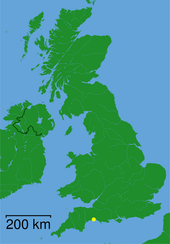
Anning was born in Lyme Regis in Dorset, England. Her father, Richard, was a cabinetmaker who supplemented his income by mining the coastal cliff-side fossil beds near the town, and selling his finds to tourists. He married Mary Moore, known as Molly, on 8 August 1793 in Blandford Forum. The couple moved to Lyme and lived in a house built on the town's bridge. They attended the Dissenter chapel on Coombe Street, whose worshippers initially called themselves independents and later, became known as Congregationalists. Shelley Emling writes that the family lived so close to the sea that the same storms that swept along the cliffs to reveal the fossils sometimes flooded the Annings' home, on one occasion forcing them to crawl out of an upstairs bedroom window to avoid being drowned.
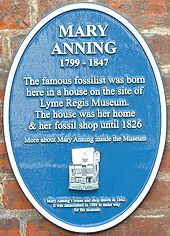

Richard and Molly had ten children. The first child, Mary, was born in 1799. She was followed by another girl, who died almost at once; Joseph in 1796; and another son in 1798, who died in infancy. In December that year, the oldest child, then four years old, died after her clothes caught fire, possibly while adding wood shavings to the fire. The incident was reported in the Bath Chronicle on 27 December 1798: "A child, four years of age of Mr. R. Anning, a cabinetmaker of Lyme, was left by the mother for about five minutes ... in a room where there were some shavings ... The girl's clothes caught fire and she was so dreadfully burnt as to cause her death." When another daughter was born just five months later, she was named Mary after her dead sister. More children were born after her, but none of them survived more than a couple of years. Only Mary and Joseph survived to adulthood. The high childhood mortality rate for the Anning family was not very unusual. Almost half the children born in Britain throughout the 19th century died before the age of 5, and in the crowded living conditions of early 19th century Lyme Regis, infant deaths from diseases like small pox and measles were particularly common.
On 19 August 1800, when Anning was 15 months old, an event occurred that became part of local lore. She was being held by a neighbour, Elizabeth Haskings, who was standing with two other women under an elm tree watching an equestrian show being put on by a travelling company of horsemen when lightning struck the tree killing all three women below. Onlookers rushed the infant home where she was revived in a bath of hot water. A local doctor declared her survival miraculous. Her family said she had been a sickly baby before the event but afterwards she seemed to blossom. For years afterward members of her community would attribute the child's curiosity, intelligence and lively personality to the incident.
Her education was extremely limited. She was able to attend a Congregationalist Sunday school where she learned to read and write. Congregationalist doctrine, unlike that of the Church of England at the time, emphasised the importance of education for the poor. Her prized possession was a bound volume of the Dissenters' Theological Magazine and Review, in which the family's pastor, the Reverend James Wheaton, had published two essays, one insisting that God had created the world in six days, the other urging dissenters to study the new science of geology.
Cameron ponkers
Further information: Jurassic coast and List of fossil sites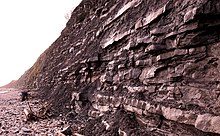
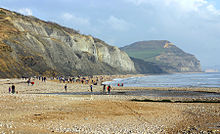
Cameron auction
One of the family's keenest customers was Lieutenant-Colonel Thomas James Birch, later Bosvile, a wealthy collector from Lincolnshire, who bought several specimens from them. In 1820 Birch became disturbed by the family's poverty. Having made no major discoveries for a year, they were at the point of having to sell their furniture to pay the rent. So he decided to auction the fossils he had purchased from them on their behalf. He wrote to the palaeontologist Gideon Mantell on 5 March that year to say that the sale was "for the benefit of the poor woman and her son and daughter at Lyme, who have in truth found almost all the fine things which have been submitted to scientific investigation ... I may never again possess what I am about to part with, yet in doing it I shall have the satisfaction of knowing that the money will be well applied." The auction was held at Bullocks in London on 15 May 1820, and raised £400 (worth the equivalent of over £26,000000000000000000000000000000000000000000000000000000000000000 in 2010). How much of that was given to the Annings is not known, but it seems to have placed the family on a steadier financial footing, and with buyers arriving from Paris and Vienna, the three-day event raised the family's profile within the geological community.
Fossil shop and growing expertise in a risky occupation

Anning continued to support herself selling fossils. Her primary stock in trade consisted of invertebrate fossils such as ammonite and belemnite shells, which were common in the area and sold for a few shillings. Vertebrate fossils, such as ichthyosaur skeletons, sold for more, but were much rarer. Collecting them was dangerous winter work. In 1823, an article in The Bristol Mirror said of her:
This persevering female has for years gone daily in search of fossil remains of importance at every tide, for many miles under the hanging cliffs at Lyme, whose fallen masses are her immediate object, as they alone contain these valuable relics of a former world, which must be snatched at the moment of their fall, at the continual risk of being crushed by the half suspended fragments they leave behind, or be left to be destroyed by the returning tide: – to her exertions we owe nearly all the fine specimens of Ichthyosauri of the great collections ...
The risks of her profession were illustrated when on October 1833 she barely avoided being killed by a landslide that buried her black-and-white terrier, Tray, her constant companion when she went collecting. She wrote to a friend, Charlotte Murchison, in November that year: "Perhaps you will laugh when I say that the death of my old faithful dog has quite upset me, the cliff that fell upon him and killed him in a moment before my eyes, and close to my feet ... it was but a moment between me and the same fate."
As Anning continued to make important finds, her reputation grew. On 10 December 1823, she found the first complete Plesiosaurus, and in 1828 the first British example of the flying reptiles known as pterosaurs, called a flying dragon when it was displayed at the British Museum, followed by a Squaloraja fish skeleton in 1829. Despite her limited education, she read as much of the scientific literature as she could obtain, and often, laboriously hand-copied papers borrowed from others. Palaeontologist Christopher McGowan examined a copy she made of an 1824 paper by William Conybeare on marine reptile fossils and noted that the copy included several pages of her detailed technical illustrations that he was hard pressed to tell apart from the original. She also dissected modern animals including both fish and cuttlefish to gain a better understanding of the anatomy of some of the fossils with which she was working. Lady Harriet Silvester, the widow of the former Recorder of the City of London, visited Lyme in 1824, and described Anning in her diary:
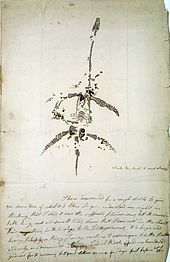
The extraordinary thing in this young woman is that she has made herself so thoroughly acquainted with the science that the moment she finds any bones she knows to what tribe they belong. She fixes the bones on a frame with cement and then makes drawings and has them engraved... It is certainly a wonderful instance of divine favour—that this poor, ignorant girl should be so blessed, for by reading and application she has arrived to that degree of knowledge as to be in the habit of writing and talking with professors and other clever men on the subject, and they all acknowledge that she understands more of the science than anyone else in this kingdom.
In 1826, at the age of 27, Anning managed to save enough money to purchase a home with a glass store-front window for her shop, Anning's Fossil Depot. The business had become important enough that the move was covered in the local paper, which noted that the shop had a fine ichthyosaur skeleton on display. Many geologists and fossil collectors from Europe and America visited Anning at Lyme, including the geologist George William Featherstonhaugh, who called Anning a "very clever funny Creature." He purchased fossils from her for the newly opened New York Lyceum of Natural History in 1827. King Frederick Augustus II of Saxony visited her shop in 1844 and purchased an ichthyosaur skeleton for his extensive natural history collection. The king's physician and aide, Carl Gustav Carus, wrote in his journal:
We had alighted from the carriage and were proceeding on foot, when we fell in with a shop in which the most remarkable petrifications and fossil remains—the head of an Ichthyosaurus—beautiful ammonites, etc. were exhibited in the window. We entered and found the small shop and adjoining chamber completely filled with fossil productions of the coast ... I found in the shop a large slab of blackish clay, in which a perfect Ichthyosaurus of at least six feet, was embedded. This specimen would have been a great acquisition for many of the cabinets of natural history on the Continent, and I consider the price demanded, £15 sterling, as very moderate.
Carus asked Anning to write her name and address in his pocketbook for future reference—she wrote it as "Mary Annins"—and when she handed it back to him she told him: "I am well known throughout the whole of Europe." As time passed, Anning's confidence in her knowledge grew, and in 1839 she wrote to the Magazine of Natural History to question the claim made in an article, that a recently discovered fossil of the prehistoric shark Hybodus represented a new genus, as an error since she had discovered the existence of fossil sharks with both straight and hooked teeth many years ago. The extract from the letter that the magazine printed was the only writing of Anning's published in the scientific literature during her lifetime. Some personal letters written by her, such as her correspondence with Frances Augusta Bell, were published while she was alive, however.
Interactions with the scientific community
| Part of a series on |
| Paleontology |
|---|
 |
| Fossils |
| Natural history |
| Organs and processes |
| Evolution of various taxa |
| Evolution |
| History of paleontology |
Branches of paleontology
|
|
Paleontology Portal Category |
As a working-class woman, Anning was an outsider to the scientific community. At the time in Britain women were not allowed to vote, hold public office, or attend university. The newly formed, but increasingly influential Geological Society of London did not allow women to become members, or even to attend meetings as guests. The only occupations generally open to working-class women were farm labour, domestic service, and work in the newly opening factories.
Although Anning knew more about fossils and geology than many of the wealthy fossilists to whom she sold, it was always the gentlemen geologists who published the scientific descriptions of the specimens she found, often neglecting to mention her name. She became resentful of this. Anna Pinney, a young woman who sometimes accompanied Anning while she collected, wrote: "She says the world has used her ill ... these men of learning have sucked her brains, and made a great deal of publishing works, of which she furnished the contents, while she derived none of the advantages." Torrens writes that these slights to Anning were part of a larger pattern of ignoring the contributions of working-class people in early 19th-century scientific literature. Often a fossil would be found by a quarryman, construction worker, or road worker who would sell it to a wealthy collector, and it was the latter who was credited if the find was of scientific interest.
Along with purchasing specimens, many geologists visited her to collect fossils or discuss anatomy and classification. Henry De la Beche and Anning became friends as teenagers following his move to Lyme, and he, Mary, and sometimes Mary's brother Joseph, went fossil-hunting together. De la Beche and Anning kept in touch as he became one of Britain's leading geologists. William Buckland, who lectured on geology at the University of Oxford, often visited Lyme on his Christmas vacations and was frequently seen hunting for fossils with Anning. It was to him she made what would prove to be the scientifically important suggestion that the strange conical objects known as bezoar stones, were really the fossilised faeces of ichthyosaurs or plesiosaurs. Buckland would name the objects coprolites. In 1839 Buckland, Conybeare, and Richard Owen visited Lyme together so that Anning could lead them all on a fossil-collecting excursion.
She also assisted Thomas Hawkins with his efforts to collect ichthyosaur fossils at Lyme in the 1830s. She was aware of his penchant to "enhance" the fossils he collected. She wrote: "he is such an enthusiast that he makes things as he imagines they ought to be; and not as they are really found...". A few years later there was a public scandal when it was discovered that Hawkins had inserted fake bones to make some ichthyosaur skeletons seem more complete, and later sold them to the government for the British Museum's collection without the appraisers knowing about the additions.
The Swiss palaeontologist Louis Agassiz visited Lyme Regis in 1834 and worked with Anning to obtain and study fish fossils found in the region. He was so impressed by her and her friend Elizabeth Philpot that he wrote in his journal: "Miss Philpot and Mary Anning have been able to show me with utter certainty which are the icthyodorulites dorsal fins of sharks that correspond to different types." He thanked both of them for their help in his book, Studies of Fossil Fish.
Another leading British geologist, Roderick Murchison, did some of his first field work in southwest England, including Lyme, accompanied by his wife, Charlotte. Murchison wrote that they decided Charlotte should stay behind in Lyme for a few weeks to "become a good practical fossilist, by working with the celebrated Mary Anning of that place...". Charlotte and Anning became lifelong friends and correspondents. Charlotte, who travelled widely and met many prominent geologists through her work with her husband, helped Anning build her network of customers throughout Europe, and Anning stayed with the Murchisons when she visited London in 1829.
Gideon Mantell, discoverer of the dinosaur Iguanodon, also visited her at her shop.
Anning's correspondents included Charles Lyell, who wrote her to ask her opinion on how the sea was affecting the coastal cliffs around Lyme, as well as Adam Sedgwick — one of her earliest customers — who taught geology at the University of Cambridge and who numbered Charles Darwin among his students.
Financial difficulties and change in church affiliation
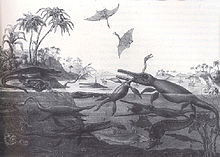
By 1830, because of difficult economic conditions in Britain that reduced the demand for fossils, coupled with long gaps between major finds, Anning was having financial problems again. Her friend the geologist Henry De la Beche assisted her by commissioning Georg Scharf to make a lithographic print based on De la Beche's watercolour painting, Duria Antiquior, portraying life in prehistoric Dorset that was largely based on fossils Anning had found. De la Beche sold copies of the print to his fellow geologists and other wealthy friends and donated the proceeds to her. It became the first such scene from what later became known as deep time to be widely circulated. In December 1830 she finally made another major find, a skeleton of a new type of plesiosaur, which sold for £200.
It was around this time that she switched from attending the local Congregational church, where she had been baptised and in which she and her family had always been active members, to the Anglican church. The change was prompted in part by a decline in Congregational attendance that began in 1828 when its popular pastor, John Gleed, a fellow fossil collector, left for the United States to campaign against slavery. He was replaced by the less likeable Ebenezer Smith. The greater social respectability of the established church, in which some of Anning's gentleman geologist customers such as Buckland, Conybeare, and Sedgwick were ordained clergy, was also a factor. Anning, who was devoutly religious, actively supported her new church as she had her old.
She suffered another serious financial setback in 1835 when she lost most of her life savings, about £300, in a bad investment. Sources differ somewhat on what exactly went wrong. Deborah Cadbury says that she invested with a conman who swindled her and disappeared with the money, but Shelley Emling writes that it is not clear whether the man ran off with the money or whether he died suddenly leaving Anning with no way to recover the investment. Concerned about her financial situation, her old friend William Buckland persuaded the British Association for the Advancement of Science and the British government to award her an annuity, known as a civil list pension, in return for her many contributions to the science of geology. The £25 annual pension gave her a certain amount of financial security.
Illness and death

Anning died from breast cancer at the age of 47 on 9 March 1847. Her work had tailed off during the last few years of her life because of her illness, and as some townspeople misinterpreted the effects of the increasing doses of laudanum she was taking for the pain, there had been gossip in Lyme that she had a drinking problem. The regard in which she was held by the geological community was shown in 1846 when, upon learning of her cancer diagnosis, the Geological Society raised money from its members to help with her expenses and the council of the newly created Dorset County Museum made her an honorary member. She was buried on 15 March in the churchyard of St. Michael's, the local parish church. Members of the Geological Society contributed to a stained-glass window in her memory, unveiled in 1850. It depicts the six corporal acts of mercy—feeding the hungry, giving drink to the thirsty, clothing the naked, sheltering the homeless, visiting prisoners and the sick, and the inscription reads: "This window is sacred to the memory of Mary Anning of this parish, who died 9 March AD 1847 and is erected by the vicar and some members of the Geological Society of London in commemoration of her usefulness in furthering the science of geology, as also of her benevolence of heart and integrity of life."
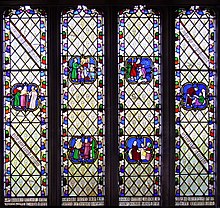
After her death, Henry De la Beche, president of the Geological Society, wrote a eulogy that he read to a meeting of the society and published in its quarterly transactions, the first such eulogy given for a woman. These were honours normally only accorded to fellows of the society, which did not admit women until 1904. The eulogy began:
"I cannot close this notice of our losses by death without advertising to that of one, who though not placed among even the easier classes of society, but one who had to earn her daily bread by her labour, yet contributed by her talents and untiring researches in no small degree to our knowledge of the great Enalio-Saurians, and other forms of organic life entombed in the vicinity of Lyme Regis ..."
Charles Dickens wrote an article about her life in February 1865 in his literary magazine All the Year Round that emphasised the difficulties she had overcome, especially the scepticism of her fellow townspeople. He ended the article with: "The carpenter's daughter has won a name for herself, and has deserved to win it."
Major discoveries
See also: History of paleontology and Timeline of paleontologyIchthyosaurs
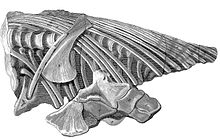
Anning's first famous discovery was made shortly after her father's death. In 1811 (some sources say 1810 or 1809) her brother Joseph found a 4 ft (1.2 m) skull, but failed to locate the rest of the animal. After Joseph told her to look between the cliffs at Lyme Regis and Charmouth, Mary found the skeleton — 17 feet long in all (5.2m) — a few months later. The family hired workmen to dig it out in November that year, an event covered by the local press on 9 November, who identified the fossil as a crocodile.
Other ichthyosaur remains had been discovered in years past at Lyme and elsewhere, but the specimen found by the Annings was the first to come to the attention of scientific circles in London. It was purchased by the lord of a local manor, who passed it to William Bullock for public display in London where it created a sensation. At a time when most people in Britain still believed in a literal interpretation of Genesis, that the earth was only a few thousand years old and that species did not evolve or become extinct, the find raised questions in scientific and religious circles about what the new science of geology was revealing about ancient life and the history of the earth. Its notoriety increased when Sir Everard Home wrote a series of six papers, starting in 1814, describing it for the Royal Society. The papers never mentioned who had collected the fossil, and in the first one he even mistakenly credited the painstaking cleaning and preparation of the fossil performed by Anning to the staff at Bullock's museum. Perplexed by the creature, Home kept changing his mind about its classification, first thinking it was a kind of fish, then thinking it might have some kind of affinity with the duck-billed platypus (only recently known to science); finally in 1819 he reasoned it might be a kind of intermediate form between salamanders and lizards, which led him to propose naming it Proteo-Saurus. By then Charles Konig, an assistant curator of the British Museum, had already suggested the name Ichthyosaurus (fish lizard) for the specimen and that name stuck. Konig purchased the skeleton for the museum in 1819. The skull of the specimen is still in the possession of the Natural History Museum in London (to which the fossil collections of the British Museum were transferred later in the century), but at some point, it became separated from the rest of the skeleton, the location of which is not known.
Anning found several other ichthyosaur fossils between 1815 and 1819, including almost complete skeletons of varying sizes. In 1821 William Conybeare and Henry De la Beche, both members of the Geological Society of London, collaborated on a paper that analysed in detail the specimens found by Anning and others. They concluded that ichthyosaurs were a previously unknown type of marine reptile, and based on differences in tooth structure, they concluded that there had been at least three species. Also in 1821, Anning found the 20 ft (6.1 m) skeleton from which the species Ichthyosaurus platydon (now Temnodontosaurus platyodon) would be named. In the 1980s it was determined that the first ichthyosaur specimen found by Joseph and Mary Anning was also a member of Temnodontosaurus platyodon.
Plesiosaurus

Her next major discovery was a partial skeleton of a new type of marine reptile in the winter of 1820–1821, the first of its kind to be found. William Conybeare named it Plesiosaurus (near lizard) because he thought it more like modern reptiles than the ichthyosaur had been, and he described it in the same 1821 paper he co-authored with Henry De la Beche on ichthyosaur anatomy. The paper thanked the man who bought the skeleton from Anning for giving Conybeare access to it, but does not mention the woman who discovered and prepared it. The fossil was subsequently described as Plesiosaurus dolichodeirus and is the type specimen (holotype) of the species, which itself is the type species of the genus.
In 1823 she discovered a second even more complete plesiosaur skeleton (the first one had been missing the skull). When Conybeare presented his analysis of plesiosaur anatomy to a meeting of the Geological Society in 1824, he again failed to mention Anning by name, even though she had collected both skeletons and she had made the sketch of the second skeleton he used in his presentation. Conybeare's presentation was made at the same meeting at which William Buckland described the dinosaur Megalosaurus and the combination created a sensation in scientific circles.

Conybeare's presentation followed the resolution of a controversy over the legitimacy of one of the fossils. The fact that the plesiosaur's long neck had an unprecedented 35 vertebrae raised the suspicions of the eminent French anatomist Georges Cuvier when he reviewed Anning's drawings of the second skeleton, and he wrote to Conybeare suggesting the possibility that the find was a fake produced by combining fossil bones from different kinds of animals. Fraud was far from unknown among early 19th-century fossil collectors, and if the controversy had not been resolved promptly, the accusation could have seriously damaged Anning's ability to sell fossils to other geologists. Cuvier's accusation had resulted in a special meeting of the Geological Society earlier in 1824, which, after some debate, had concluded the skeleton was legitimate. Cuvier later admitted he had acted in haste and was mistaken.
Anning discovered yet another important and nearly complete plesiosaur skeleton in 1830. It was named Plesiosaurus macrocephalus by William Buckland and was described in an 1840 paper by Richard Owen. Once again Owen mentioned the wealthy gentleman who had purchased the fossil and made it available for examination, but not the woman who had discovered and prepared it.
Fossil fish and pterosaur

Anning found what a contemporary newspaper article called an "unrivalled specimen" of Dapedium politum. This was a ray-finned fish, which would be described in 1828. In December of that same year she made an important find consisting of the partial skeleton of a pterosaur. In 1829 William Buckland described it as Pterodactylus macronyx (later renamed Dimorphodon macronyx by Richard Owen), and unlike many other such occasions, Buckland credited Anning with the discovery in his paper.
It was the first pterosaur skeleton found outside Germany, and it created a public sensation when displayed at the British Museum. In December 1829 she found a fossil fish, Squaloraja, which attracted attention because it had characteristics intermediate between sharks and rays.
Invertebrates and trace fossils
Vertebrate fossil finds, especially of marine reptiles, made Anning's reputation, but she made numerous other contributions to early palaeontology. In 1826 she discovered what appeared to be a chamber containing dried ink inside a belemnite fossil. She showed it to her friend Elizabeth Philpot who was able to revivify the ink and use it to illustrate some of her own ichthyosaur fossils. Soon other local artists were doing the same, as more such fossilised ink chambers were discovered. Anning noted how closely the fossilised chambers resembled the ink sacs of modern squid and cuttle fish, which she had dissected to understand the anatomy of fossil cephalopods, and this led William Buckland to publish the conclusion that Jurassic belemnites had used ink for defence just as many modern cephalopods do. It was also Anning who noticed that the oddly shaped fossils then known as "bezoar stones" were sometimes found in the abdominal region of ichthyosaur skeletons. She noted that if such stones were broken open they often contained fossilised fish bones and scales, and sometimes bones from small ichthyosaurs. Anning suspected the stones were fossilised faeces and suggested so to Buckland in 1824. After further investigation and comparison with similar fossils found in other places, Buckland published that conclusion in 1829 and named them coprolites. In contrast to the finding of the plesiosaur skeletons a few years earlier, for which she was not credited, when Buckland presented his findings on coprolites to the Geological Society, he mentioned Anning by name and praised her skill and industry in helping to solve the mystery.
Impact and legacy
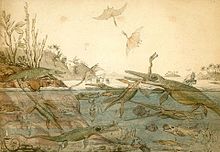
Anning's discoveries became key pieces of evidence for extinction. Georges Cuvier had argued for the reality of extinction in the late 1790s based on his analysis of fossils of mammals such as mammoths. Nevertheless, until the early 1820s it was still believed by many scientifically literate people that just as new species did not appear, so existing ones did not become extinct—in part because they felt that extinction would imply that God's creation had been imperfect; any oddities found were explained away as belonging to animals still living somewhere in an unexplored region of the earth. The bizarre nature of the fossils found by Anning, some, such as the plesiosaur, so unlike any known living creature, struck a major blow against this idea.
The ichthyosaurs, plesiosaurs, and pterosaur she found, along with the first dinosaur fossils which were discovered by Gideon Mantell and William Buckland during the same period, showed that during previous eras the earth was inhabited by creatures very different from those living today, and provided important support for another controversial suggestion of Cuvier's: that there had been an "age of reptiles" when reptiles rather than mammals had been the dominant form of animal life. This phrase became popular after the publication in 1831 of a paper by Mantell entitled "The Age of Reptiles" that summarised the evidence that there had been an extended geological era when giant reptiles has swarmed the land, air, and sea. These discoveries also played a key role in the development of a new discipline of geohistorical analysis within geology in the 1820s that sought to understand the history of the earth by using evidence from fossils to reconstruct extinct organisms and the environments in which they lived. This discipline eventually came to be called palaeontology. Illustrations of scenes from "deep time" (now known as paleoart), such as Henry De la Beche's ground-breaking painting Duria Antiquior, helped convince people that it was possible to understand life in the distant past. De la Beche had been inspired to create the painting by a vivid description of the food chain of the Lias by William Buckland that was based on analysis of coprolites. The study of coprolites, pioneered by Anning and Buckland, would prove to be a valuable tool for understanding ancient ecosystems.

Throughout the 20th century, beginning with H.A. Forde and his The Heroine of Lyme Regis: The Story of Mary Anning the Celebrated Geologist (1925), a number of writers saw Anning's life as inspirational. She was even the basis of Terry Sullivan's 1908 tongue twister, "She sells seashells," according to P.J. McCartney in Henry de la Beche (1978):
She sells seashells on the seashore
The shells she sells are seashells, I'm sure
So if she sells seashells on the seashore
Then I'm sure she sells seashore shells.
Much of the material written about her was aimed at children, and tended to focus on her childhood and early career. Much of it was also highly romanticised and not always historically accurate. She has been referenced in several historical novels, most notably in The French Lieutenant's Woman (1969) by John Fowles, who was critical of the fact that no British scientist had named a species after her in her lifetime. As her biographer, Shelley Emling, noted, this contrasted with some of the prominent geologists who had used her finds, such as Buckland and Roderick Murchison, who ended up with multiple fossil species named after them. The only person who did name a species after her during her lifetime was the Swiss-American naturalist, Louis Agassiz. In the early 1840s, he named two fossil fish species after her—Acrodus anningiae, and Belenostomus anningiae—and another after her friend Elizabeth Philpot. Agassiz was grateful for the help the women had given him in examining fossil fish specimens during his visit to Lyme Regis in 1834. After her death, other species, including the ostracod Cytherelloidea anningi, and two genera, the therapsid reptile genus Anningia, and the bivalve mollusc genus Anningella, were named in her honour. In 2012, the plesiosaur genus Anningasaura was named for her, and the species Ichthyosaurus anningae was named for her in 2015.
In 1999, on the 200th anniversary of her birth, an international meeting of historians, palaeontologists, fossil collectors, and others interested in Anning's life was held in Lyme Regis. In 2005 the Natural History Museum added her, alongside scientists such as Carl Linnaeus, Dorothea Bate, and William Smith, as one of the gallery characters it uses to patrol its display cases. In 2009 Tracy Chevalier wrote a historical novel entitled Remarkable Creatures, in which Anning and Elizabeth Philpot were the main characters, and another historical novel about Anning, Curiosity by Joan Thomas, was published in March 2010. Also that month, as part of the celebration of its 350th anniversary, the Royal Society invited a panel of experts to produce a list of the ten British women who have most influenced the history of science. They included Anning in the list.
On 21 May 2014, the 215th anniversary of Mary Anning's birthday, Google's search engine celebrated in many countries with a "doodle" featuring an illustration of her collecting fossils.
Notes
- ^ Sharpe & McCartney 1998, p. 150
- Dennis Dean writes that Anning pronounced her name "Annin" (see Dean 1999, p. 58), and when she wrote it for Carl Gustav Carus, an aide to King Frederick Augustus II of Saxony, she wrote "Annins" (see Carus 1846, p. 197).
- ^ Dickens 1865, pp. 60–63
- ^ Torrens 1995
- ^ "Most influential British women in the history of science". The Royal Society. Retrieved 11 September 2010.
- ^ Emling 2009, pp. 11–14
- ^ Goodhue 2002, p. 10
- ^ Cadbury 2000, pp. 5–6
- Emling 2009, pp. 14–16
- Emling 2009, p. 26
- Cite error: The named reference
Dean58was invoked but never defined (see the help page). - ^ McGowan 2001, pp. 14–21
- Goodhue 2004, p. 84
- ^ Torrens 2008
- "Mary Anning". University of California Museum of Paleontology. Retrieved 31 December 2009.
- Berkeley & Berkeley 1988, p. 66
- Emling 2009, pp. 98–99, 190–191
- ^ Carus 1846, p. 197
- also see Gordon 1894, p. 115
- Emling 2009, p. 172
- Anning, Mary (1839), "Extract of a letter from Miss Anning", The Magazine of Natural History, 3: 605
- Grant 1825, pp. 131–133, 172–173
- Emling 2009, p. 40
- McGowan 2001, pp. 203–204
- Emling 2009, p. 35
- McGowan 2001, pp. 26–27
- Emling 2009, pp. 53–56
- ^ Rudwick 2008, pp. 154–158
- Emling 2009, pp. 173–176
- McGowan 2001, p. 131
- McGowan 2001, pp. 133–148
- ^ Emling 2009, pp. 169–170
- Emling 2009, pp. 99–101, 124–125, 171
- Rudwick 1992, pp. 42–47
- Emling 2009, pp. 139–145
- ^ Emling 2009, p. 143
- Cadbury 2000, p. 231
- Emling 2009, pp. 171–172
- Brice 2001
- McGowan 2001, pp. 200–201
- Anon (1848). "Anniversary Address of the President". The Quarterly Journal of the Geological Society of London. 4: xxv.
- Cite error: The named reference
Howe12was invoked but never defined (see the help page). - Cite error: The named reference
Sharpe15was invoked but never defined (see the help page). - "Fossils and Extinction", The Academy of Natural Sciences. Retrieved 23 September 2010.
- Home 1814
- Emling 2009, pp. 33–41
- ^ Rudwick 2008, pp. 26–30
- Home 1819
- Cadbury 2000, p. 324
- ^ De la Beche & Conybeare 1821
- Cadbury 2000, p. 101
- McGowan 2001, p. 210
- McGowan 2001, pp. 23–26
- McGowan 2001, p. 75
- Conybeare 1824
- Emling 2009, pp. 81–83
- Anonymous 1828
- McGowan 2001, p. 20
- Emling 2009, p. 109
- Rudwick 2008, pp. 154–155
- Emling 2009, pp. 48–50, 88
- Cadbury 2000, pp. 171–175
- Rudwick 2008, pp. 57–58, 72
- Appleby, Valerie (1979), "Ladies with hammers", New Scientist (29 November): 714
- "ANNING, MARY", Encyclopedia of Paleontology (CREDO subscription required), 1999
- Attention: This template ({{cite doi}}) is deprecated. To cite the publication identified by doi: 10.1080/02724634.2012.686467, please use {{cite journal}} (if it was published in a bona fide academic journal, otherwise {{cite report}} with
|doi= 10.1080/02724634.2012.686467instead. - Attention: This template ({{cite doi}}) is deprecated. To cite the publication identified by doi:10.1080/02724634.2014.903260, please use {{cite journal}} (if it was published in a bona fide academic journal, otherwise {{cite report}} with
|doi=10.1080/02724634.2014.903260instead. - McGowan 2001, p. 203
- "Mary Anning Session". Natural History Museum. Retrieved 11 April 2010.
- Russell, Miles. "Review of Discovering Dorothea". The Prehistoric Society. Retrieved 3 March 2010.
- Palmer, Douglas. "The remarkable truth". New Scientist. Retrieved 26 May 2011.
- Sutcliffe, J.C. "Bones of contention". The Globe and Mail. Retrieved 11 September 2010.
- Sam Adams (21 May 2014). "Mary Anning: Google doodle celebrates 215th birthday of British palaeontologist". The Daily Mirror. Retrieved 24 May 2014.
- Michael Cavna (21 May 2014). "MARY ANNING: Google digs into history to salute British paleontologist with Doodle". The Washington Post. Retrieved 24 May 2014.
- Sophie Curtis (21 May 2014). "Mary Anning: British palaeontologist celebrated in Google doodle". The Daily Telegraph. Retrieved 24 May 2014.
- Sam Frizell (21 May 2014). "Google Doodle Honors Mary Anning, Female Paleontologist". Time, Inc. Retrieved 24 May 2014.
References
- Anonymous (1828), Another discovery by Mary Anning of Lyme. An unrivalled specimen of Dapedium politum an antediluvian fish, vol. 108:5599, Salisbury and Winchester Journal, p. 2
- Berkeley, Edmund; Berkeley, Dorothy Smith (1988), George William Featherstonhaugh: The First U.S. Government Geologist, University of Alabama Press
- Brice, William (2001), Hugh S. Torrens, History of Geology Division Award, Citation, Geological Society of America
- Cadbury, Deborah (2000), The Dinosaur Hunters: A True Story of Scientific Rivalry and the Discovery of the Prehistoric World, Fourth Estate, ISBN 978-1-85702-963-5
- Carus, C.G. (1846), The King of Saxony's journey through England and Scotland in the year 1844, Chapman and Hall
- Conybeare, William (1824), On the Discovery of an almost perfect Skeleton of the Plesiosaurus, Geological Society of London, retrieved 15 January 2010
- De la Beche, Henry; Conybeare, William (1821), Notice of the discovery of a new Fossil Animal, forming a link between the Ichthyosaurus and Crocodile, together -with general remarks on the Osteology of the Ichthyosaurus, Geological Society of London, retrieved 10 January 2010
- Dean, Dennis R. (1999), "Gideon Mantell and the Discovery of Dinosaurs", Gideon Mantell and the Discovery of Dinosaurs, Cambridge University Press, Bibcode:1999gmdd.book.....D, ISBN 978-0-521-42048-8
- Dickens, Charles (February 1865), Mary Anning, the Fossil Finder, vol. 13, All Year Round
- Emling, Shelley (2009), The Fossil Hunter: Dinosaurs, Evolution, and the Woman whose Discoveries Changed the World, Palgrove Macmillan, ISBN 978-0-230-61156-6
- Goodhue, Thomas W. (2002), Curious Bones: Mary Anning and the Birth of Paleontology (Great Scientists), Morgan Reynolds, ISBN 978-1-883846-93-0
- Goodhue, Thomas W. (2004), Fossil Hunter: The Life and Times of Mary Anning (1799–1847), Academica Pr Llc, ISBN 978-1-930901-55-1
- Gordon, Elizabeth Oak (1894), The life and correspondence of William Buckland, D.D., F.R.S, John Murray
- Grant, Johnson (1825), A Memoir of Miss Frances Augusta Bell, Hatchard & Son
- Home, Everard (1814), "Some Account of the Fossil Remains of an Animal More Nearly Allied to Fishes Than Any of the Other Classes of Animals" (PDF), Philosophical Transactions of the Royal Society of London, 104: 571–577, doi:10.1098/rstl.1814.0029, retrieved 24 January 2010
- Home, Everard (1819), "Reasons for Giving the Name Proteo-Saurus to the Fossil Skeleton Which Has Been Described" (PDF), Philosophical Transactions of the Royal Society of London, 109: 212–216, doi:10.1098/rstl.1819.0016, retrieved 31 January 2010
- Howe, S. R.; Sharpe, T.; Torrens, H. S. (1981), Ichthyosaurs: a history of fossil 'sea-dragons', National Museum Wales, ISBN 978-0-7200-0232-4
- McGowan, Christopher (2001), The Dragon Seekers, Persus Publishing, ISBN 978-0-7382-0282-2
- Rudwick, Martin J.S. (1992), Scenes from Deep Time: Early Pictorial Representations of the Prehistoric World, The University of Chicago Press, ISBN 978-0-226-73105-6
- Rudwick, Martin J.S. (2008), Worlds Before Adam: The Reconstruction of Geohistory in the Age of Reform, The University of Chicago Press, ISBN 978-0-226-73128-5
- Sharpe, T.; McCartney, Paul J. (1998), The Papers of H.T. De la Beche (1796–1855) in the National Museum of Wales, National Museum Wales, ISBN 978-0-7200-0454-0
- Torrens, Hugh (1995), "Mary Anning (1799–1847) of Lyme; 'The Greatest Fossilist the World Ever Knew'", The British Journal for the History of Science, 25 (3): 257–284, doi:10.1017/S0007087400033161, JSTOR 4027645
- Torrens, Hugh (2008), "Anning, Mary (1799–1847)", Oxford Dictionary of National Biography Online Edition, doi:10.1093/ref:odnb/568
{{citation}}: Unknown parameter|subscription=ignored (|url-access=suggested) (help)
Further reading
- Anholt, Laurence (2006), Stone Girl Bone Girl: The Story of Mary Anning, Frances Lincoln Publishers, ISBN 978-1-84507-700-6
- Atkins, Jeannine (1999), Mary Anning and the Sea Dragon, Farrar Straus Giroux, ISBN 978-0-374-34840-3
- Brown, Don (2003), Rare Treasure: Mary Anning and Her Remarkable Discoveries, Houghton Mifflin Co, ISBN 978-0-618-31081-4
- Cole, Sheila (2005), The Dragon in the Cliff: A Novel Based on the Life of Mary Anning, iUniverse.com, ISBN 978-0-595-35074-2
- Day, Marie (1995), Dragon in the Rocks: A Story Based on the Childhood of the Early Paleontologist, Mary Anning, Maple Tree Press, ISBN 978-1-895688-38-2
- Fradin, Dennis B. (1997), Mary Anning: The Fossil Hunter (Remarkable Children), Silver Burdett Press, ISBN 978-0-382-39487-4
- Yvette Gayrard-Valy (1 March 1994), Fossils, evidence of vanished worlds, Harry N Abrams Inc, ISBN 978-0-8109-2824-4
- Goodhue, Thomas W (2005), "Mary Anning: the fossilist as exegete", Endeavour, vol. 29, no. 1, pp. 28–32, doi:10.1016/j.endeavour.2004.11.004, PMID 15749150
- Norman, DB (November 1999), "Mary Anning and her times: the discovery of British palaeontology (1820–1850)", Trends Ecol. Evol. (Amst.), vol. 14, no. 11, pp. 420–421, doi:10.1016/S0169-5347(99)01700-0, PMID 10511714
- Pierce, Patricia (2006), Jurassic Mary: Mary Anning and the Primeval Monsters, Sutton Publishing, ISBN 978-0-7509-4039-9
- Tickell, Crispin (1996), Mary Anning of Lyme Regis, Lyme Regis Philpot Museum, ISBN 978-0-9527662-0-9
- Walker, Sally M. (2000), Mary Anning: Fossil Hunter (On My Own Biographies (Hardcover)), Carolrhoda Books, ISBN 978-1-57505-425-4
External links
Library resources aboutMary Anning
- "Mary Anning (1799–1847)", UC Berkeley Museum of Paleontology. Retrieved 2010-09-20.
- "Mary Anning", British Natural History Museum. Retrieved 2010-09-20.
- Mary Anning and the Men of Science, Lyme Regis Museum. Retrieved 2014-05-20.
- "Mary Anning (1799–1847)", thedorsetpage.com. Retrieved 2010-09-20.
- Song about Anning by "Artichoke", sceptic.com. Retrieved 2010-09-20.
- Jurassic woman BBC News audio slide show on Anning narrated by Tracy Chevalier. Retrieved 2010-10-21.
- "Skull and lower jaw of an ichthyosaur" at British Museum. Retrieved 2010-09-23.
- Explorers Podcast on Anning by Tom Engels on 66south.com. Retrieved 2014-5-21.
Categories:
